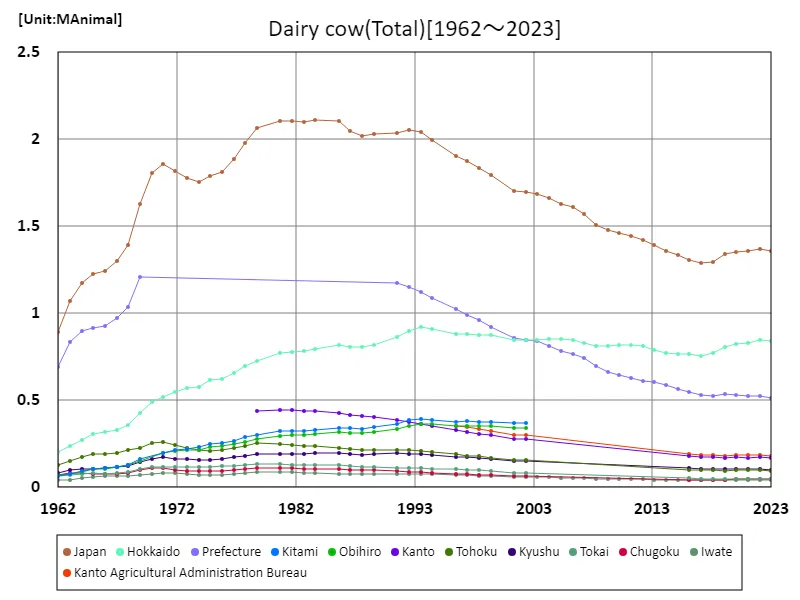Abstract
In Japan’s livestock industry, the number of dairy cows is an important indicator. According to statistics for 2023, the total number of dairy cows nationwide reached 1.36 million. This figure reflects the trend over the past few years, continuing a steady upward trend. Statistics on cattle rearing, particularly those with more than 300 and more than 200 cattle, indicate the presence of large-scale livestock producers. This suggests a strong tendency to seek economies of scale. Also, the fact that the crop meter is the largest indicates that dairy cattle production is the core of the country’s livestock industry. This trend can be attributed to technological advances and increased production efficiency. This has ensured a stable domestic supply of dairy products and ensured that the livestock industry plays an important role in the national economy.
Total number of adult dairy cattle
The number of dairy cows in Japanese agriculture has fluctuated between 1962 and 2023. In 1984, there were 2.11 million dairy cows raised nationwide, which was the peak. However, in the decades since then, dairy cow numbers have declined and are now down to just 64.3% of their peak. The decline is due to an increase in imported dairy products and a decrease in farmland due to urbanization. In addition, modernization of agriculture and technological advances have increased productivity, making it possible to meet demand with fewer cattle. This trend reflects structural changes in Japanese agriculture and socio-economic changes.


The maximum is 2.11MAnimal[1984] of Japan, and the current value is about 64.3%
Total number of adult dairy cattle (prefecture, latest year)
The number of dairy cows in Japanese agriculture in 2023 peaked in Hokkaido at 843,000 head. Hokkaido has achieved 100% of this figure compared to its peak. This number is noteworthy. Hokkaido is a major dairy producing region in Japan and plays an important role in raising dairy cattle. This peak is likely due to regional agricultural policies, technological advances and improved production efficiency. Changes in the region’s agricultural structure and demand are also having an impact. Hokkaido’s growing dairy cattle population plays an important role in the local economy and contributes to Japan’s overall dairy supply.


The maximum is 843kAnimal of Hokkaido, the average is 28.8kAnimal, and the total is 1.36MAnimal
Total number of animals kept over 300
The livestock statistics for dairy cows in Japan’s agriculture industry in 2023, with over 300 head, are noteworthy. Hokkaido boasts the highest number of cattle at 181,000, with the overall average being 16,000, for a total of 271,000 cattle. This indicates that Hokkaido is the leading region in Japan for dairy cattle breeding. Hokkaido’s vast number of dairy cows far exceeds that of any other region, meaning the region is a major source of dairy products. Additionally, the overall average is relatively high at 16,000 head, suggesting the existence of large-scale livestock producers. This figure is likely due to technological advances and improved production efficiency. These statistics provide important insights into the structure of agriculture in Japan and regional variations.


The maximum is 843kAnimal of Hokkaido, the average is 28.8kAnimal, and the total is 1.36MAnimal
Total number of animals kept over 200
The statistics on the number of adult dairy cattle kept in Japanese agriculture by farm size in 2023 are interesting. Hokkaido boasts the highest number of heads of cattle overall at 260,000, with the overall average being 14,600, for a total of 395,000. This data makes it clear that Hokkaido is the leading region in Japan for dairy cattle rearing. The number of dairy cows in Hokkaido far exceeds that of other regions, indicating that the region is a major source of dairy products. Additionally, the overall average is relatively high at 14,600 head, suggesting the existence of large-scale livestock producers. This is thought to be due to technological advances and improved production efficiency. These statistics are a valuable source of information for understanding the structure of agriculture in Japan and regional differences.


The maximum is 843kAnimal of Hokkaido, the average is 28.8kAnimal, and the total is 1.36MAnimal



Comments